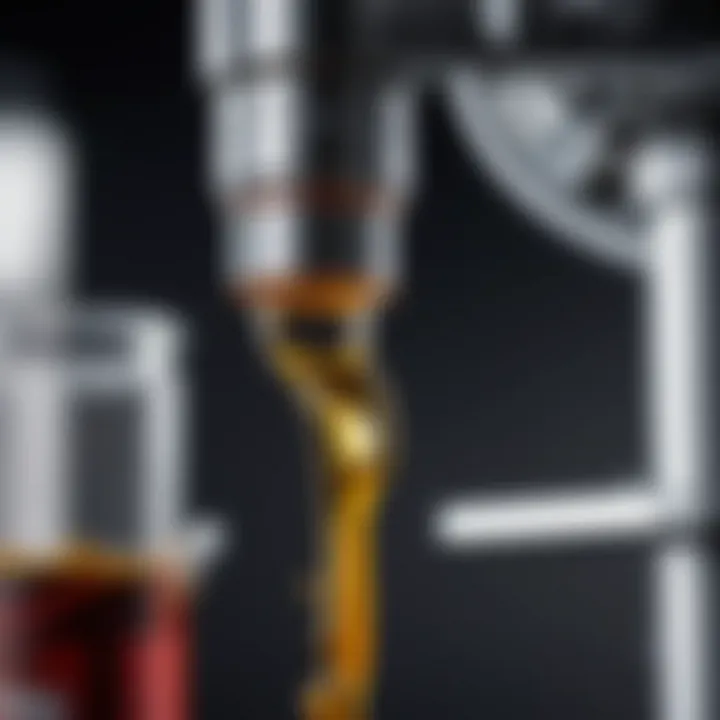Oil Dispensing Bottles: Enhancing Kitchen Efficiency


Intro
Oil dispensing bottles play a significant role in both culinary and professional environments. Their design and functionality directly impact how efficiently they can be used by chefs and home cooks alike. Understanding the various types available and their applications can enhance the efficiency of any kitchen, especially when daily activities require smart organization and easy access to cooking essentials. This article aims to provide a detailed exploration of oil dispensing bottles, covering everything from key designs and features to practical considerations for selection and maintenance.
Актуальные акции и скидки
Обзор текущих предложений
In the current market, oil dispensing bottles come in a wide range of styles and materials. Many retailers offer promotions that make it easier to acquire high-quality products without breaking the bank.
Some popular stores currently provide discounts on select items, making it a great time to purchase. Look out for sales on brands such as OXO, a leader in kitchen products known for their durability and innovative designs, or even plastic options that are lighter and more affordable.
Специальные предложения от популярных брендов
Brands like Pyrex and Chef'n have ongoing special promotions, with some limited-time offers on their product lines. These discounts are particularly beneficial for families or individuals shopping with a budget in mind. Finding the right oil dispensing bottle can be a simple task if one keeps an eye out for these limited-time deals.
Рекомендуемые товары
Топ товаров со скидками
When searching for top-rated oil dispensing bottles, consider these:
- OXO Good Grips Liquid Soap Dispenser: Known for its sleek design and ease of use.
- Chef'n Slaw Dressing Dispenser: Ideal for blending and dispensing sauces or oils seamlessly.
- Mason Jar Pouring Lid Set: A versatile option that fits standard mason jars; perfect for homemade infused oils.
Товары, которые стоит купить по сниженной цене
For those looking for quality without the hefty price tag, you might consider:
- Bergland Oil and Vinegar Dispenser Set: Often available at discount and looks elegant on any table setting.
- Eden's Garden Glass Oil Bottle: Simple yet effective, a great addition to any kitchen at a reasonable price.
These product suggestions can vary based on season and stock levels but provide a good starting point for budget-conscious consumers looking for quality.
Remember to regularly check local retail and online platforms for the latest offers. Staying informed about promotions can significantly enhance your shopping experience and ensure you select the best options for your needs.
The ability to shop wisely can extend not just savings but also elevate your kitchen organization and functionality. In the following sections of the article, we will delve more into the specifics of choosing, using, and maintaining oil dispensing bottles to ensure you become a knowledgeable consumer.
Preamble to Oil Dispensing Bottles
Oil dispensing bottles play a crucial role in both domestic and professional kitchens. Their primary function is to provide an efficient, convenient, and precise means of dispensing various types of oils, including olive oil, vegetable oil, and specialty oils. Understanding the features and advantages of these bottles is essential for anyone looking to optimize their cooking experience.
One significant benefit of oil dispensing bottles is their ability to control pouring. Unlike traditional containers, these bottles often come equipped with specialized spouts or mechanisms that allow for a measured flow. This precision not only helps in achieving desired flavors but also aids in maintaining portion control, thereby reducing waste.
Moreover, these bottles vary in material, design, and size, catering to diverse consumer preferences and needs. From sleek glass options that enhance countertop aesthetics to durable plastic bottles, the choices are plentiful. Each type of material has its own set of advantages and potential downsides. For instance, glass bottles are less prone to leaking but can be heavier and more fragile than plastic counterparts.
"Choosing the right oil dispensing bottle is key to maximizing its utility in the kitchen."
In addition to usability, oil dispensing bottles also contribute to better storage practices. They often feature designs that limit oxidation exposure, which is beneficial for oil longevity. Thoughtfully designed products also simplify cleaning processes, an essential consideration for maintaining hygiene in cooking environments.
In summary, oil dispensing bottles combine functionality with convenience. They encourage users to engage more with their cooking process while allowing for creative exploration in the kitchen. In this article, we will delve into various types of oil dispensing bottles, their dispensing mechanisms, and key factors for choosing the right one to suit individual kitchen needs.
Types of Oil Dispensing Bottles
Understanding the types of oil dispensing bottles is essential for their effective use in both home and commercial settings. Each type of bottle offers unique benefits, catering to various needs and preferences. Choosing correctly can streamline cooking processes, enhance user experiences, and even promote better storage practices. The right bottle ensures accurate dispensing, minimizes waste, and can make the difference between an efficient and a frustrating experience in the kitchen.
Plastic Oil Bottles
Plastic oil bottles are popular due to their lightweight nature and durability. These bottles are often made from high-density polyethylene or other plastics that are resistant to impact. The flexibility in design allows for diverse shapes and sizes, catering to various consumer needs. Additionally, plastic bottles are typically available at lower price points than glass or metal alternatives, making them an appealing option for budget-conscious consumers.
One major advantage is their resistance to shattering. In busy kitchens, accidents happen, and having a non-breakable option can save time and money. However, it’s important to note that not all plastics are created equal. When selecting a plastic oil bottle, ensure it is BPA-free to avoid any harmful chemicals leaching into the oil.
Glass Oil Bottles
Glass oil bottles offer a more premium feel and can elevate the presentation of oils. They are ideal for those who appreciate aesthetics in their kitchenware. Glass does not react with oils, ensuring the integrity of the product over time. Moreover, glass is easy to clean and does not retain odors or stains, making it a hygienic choice for oil storage.
While glass has many benefits, it does come with some drawbacks. The primary concern is their fragility. Glass bottles can break easily, especially in high-traffic areas like kitchens. Gearing towards safe handling and storage can mitigate this risk. Also, they are usually heavier than their plastic counterparts, which can be a consideration for some users.
Stainless Steel Oil Bottles
Stainless steel oil bottles are seen as a modern choice, combining durability with a sleek design. These bottles are resistant to rust, corrosion, and staining. They do not react with the oils stored within, ensuring product quality over time. Stainless steel bottles are also environmentally friendly, being recyclable at the end of their life cycle.
In terms of use, stainless steel options often come with good sealing mechanisms, which help in preventing leaks and providing precise dispensing. However, the cost can be a concern; stainless steel options are generally more expensive than plastic. Still, their longevity often justifies the investment for many consumers, especially those looking for a durable solution.
"Choosing the right material for your oil dispensing bottle is crucial. Each has its merits, depending on user preferences and kitchen environment."
In summary, selecting the right type of oil dispensing bottle involves considering several factors. Plastic bottles are economical and lightweight, glass bottles bring an aesthetic appeal and purity of content, while stainless steel bottles provide durability and sustainability. Each category serves a significant role in the overall efficiency and enjoyment of cooking.
Mechanisms of Dispensing
Understanding the mechanisms of dispensing oil is crucial for users seeking efficiency and precision in their application. Different mechanisms provide various advantages. They can influence the control over the pour rate, minimize mess, and enhance the overall experience of using oil dispensing bottles. Each mechanism has unique characteristics that cater to specific user needs.


Pour Spouts
Pour spouts are designed to facilitate an easy flow of liquid from the bottle. They often come with a hinged cap that can be opened with one hand, allowing for convenient operation. The spout's shape helps in controlling the volume of oil dispensed. A pointed spout gives added accuracy, which is essential for recipes that require precise measurements.
The practical application of pour spouts is notable in both home kitchens and professional environments. This mechanism reduces spillage, saving money on oil and preventing unnecessary waste. In some cases, the pour spouts are detachable. This makes cleaning the bottle easier and can improve hygiene, especially in a culinary context.
Pump Mechanisms
Pump mechanisms offer a different level of control compared to pour spouts. With a push or pull action, users can dispense a consistent amount of oil without the need for tilting the bottle. This is particularly advantageous in commercial kitchens, where speed and volume are critical.
In addition to providing a steady flow, pump mechanisms are often designed with a secure closure, which helps in maintaining the integrity of the oil, preventing oxidation or contamination. They are easier to use and manage, especially when handling larger quantities. Users often find pump bottles not just practical but also ergonomic, making them a preferred choice.
Squeeze Bottles
Squeeze bottles are another innovative option in the realm of oil dispensing. They work via manual pressure on the bottle body, allowing the user to control the amount of oil dispensed. This mechanism is user-friendly, particularly for individuals who may not be as experienced in the kitchen.
The forgiving nature of squeeze bottles is also a strong selling point. They provide flexibility and are less likely to cause messes, as users can dispense oil at a slow rate if needed. Moreover, they are lightweight and portable, making them suitable for picnics or outdoor cooking. However, it is essential to select squeeze bottles made from durable materials to ensure that they withstand repeated use without damage.
In summary, choosing the right mechanism for an oil dispensing bottle is critical. Each type—pour spouts, pump mechanisms, and squeeze bottles—offers specific benefits, making them suitable for various applications. Understanding these can lead to a more satisfactory kitchen experience.
Choosing the Right Oil Dispensing Bottle
Selecting the appropriate oil dispensing bottle is vital for both functionality and efficiency. When a bottle is chosen carefully, it enhances precision in pouring and minimizes waste. The right bottle can also add a touch of style to a kitchen or workspace, reflecting personal taste or brand identity. Considering the various aspects associated with oil dispensing bottles helps in making an informed decision. Factors to weigh include capacity, material, and design aesthetics.
Capacity Considerations
Capacity refers to how much oil the bottle can hold. It is essential to assess one’s usage needs before buying. A larger bottle may be appropriate for those who cook frequently or use oil in other applications, while a smaller bottle could suffice for occasional use. Various sizes are available:
- Small (100-250 ml): Ideal for specialty oils or infrequent use.
- Medium (500 ml): A common size suitable for everyday cooking.
- Large (1 liter or more): Best suited for commercial kitchens or heavy oil users.
Understanding daily usage can help avoid both over-purchasing and under-utilizing oil, ultimately leading to better cost management.
Material Selection
Choosing the right material for an oil dispensing bottle impacts not only durability but also the oil’s longevity. The most common materials include:
- Plastic: Lightweight and shatterproof, but can absorb flavors over time.
- Glass: Non-reactive and ideal for preserving flavor, yet fragile.
- Stainless Steel: Durable and visually appealing, it provides a modern touch to any kitchen, and it is easy to clean.
The choice of material should align with the type of oil being stored and personal preferences regarding care and maintenance.
Design Aesthetics
Design aesthetics should not be overlooked when selecting an oil dispensing bottle. The appearance can enhance the overall look of the kitchen or dining area. Factors include:
- Color and Finish: Options range from clear and understated to colored or decorative.
- Shape: A bottle can be tall and slender for easy pouring or broader for stability.
- Labels: Clear labeling enhances functionality and ensures easy identification of oils.
By considering design, one can ensure that the oil dispensing bottle complements the kitchen decor while serving its functional purpose effectively.
Choosing the right oil dispensing bottle is not merely a practical task; it is an opportunity to blend functionality with personal style.
In summary, the decision-making process around oil dispensing bottles encompasses careful thought about capacity, material, and design. Making the right choices promotes better cooking practices, reduces waste, and elevates the overall kitchen experience.
Benefits of Using Oil Dispensing Bottles
Oil dispensing bottles provide a variety of benefits that significantly enhance the usability and effectiveness of oil in various settings, especially in kitchens. The benefits encompass precision in pouring, minimization of waste, and enhanced storage solutions. Understanding these advantages can help consumers and professionals alike make informed choices for their cooking needs.
Precision in Pouring
One of the most critical advantages of using oil dispensing bottles is the precision they offer when pouring. Many of these bottles come equipped with specially designed spouts or pumps that allow for controlled flow. This precision is essential in cooking, where the amount of oil can affect the final taste and texture of a dish. For instance, when a recipe calls for a specific amount of olive oil, having an oil dispenser that allows for exact measurements can prevent unnecessary overuse.
Moreover, some designs feature graduated measurements on the side of the bottle. This makes it easier to see how much oil is being used. A precise pour can prevent oil from spilling, which is especially helpful in commercial kitchens where time and resources are crucial.
Minimization of Waste
Oil dispensing bottles are also beneficial for minimizing waste. Traditional oil containers often lead to a mess during pouring; oil can drip and spill, resulting in wasted product. However, dispensing bottles are designed to reduce the chances of overflow. When users can control the flow, less oil is lost during the cooking or serving process.
In addition, a well-designed dispensing bottle can make every drop count. Some bottles are engineered to make effective use of the oil inside, ensuring that every bit can be used before disposal. As consumers become more budget-conscious, decreasing waste has become an important consideration in household management.
"Effective use of kitchen resources contributes not only to financial savings but also promotes a responsible approach to cooking."
Enhanced Storage
The storage capabilities of oil dispensing bottles are another crucial benefit. Many bottles are designed for optimal space-saving in kitchens. Their sizes often allow them to fit into cabinets or alongside other kitchen supplies without taking up much room.
Furthermore, these bottles can help maintain the quality of the oil. Many are specifically designed to protect the contents from light and air, which are factors that can lead to oil rancidity. Using a well-constructed dispenser ensures that the oil remains fresh for a more extended period, which is particularly vital for specialty oils that may have a shorter shelf life.
In summary, these benefits make oil dispensing bottles not just functional tools but essential components for any efficient kitchen. From allowing precise control of oil to minimizing waste and enhancing storage possibilities, the advantages are clear. This understanding is important for both casual home cooks and professional chefs who want to optimize their culinary practices.
Oil Dispensing Bottles for Specific Oils


In this section, we will explore the specific applications of oil dispensing bottles for various types of oils. Each type of oil has its own unique properties and requires careful consideration for optimal storage and dispensing. Understanding these aspects can significantly enhance usability and improve overall experience when using oil dispensers. Different oils may have varying viscosities and characteristics, which means the right bottle can help maintain the oil’s quality while ensuring proper dispensing.
Olive Oil
Olive oil is well known for its rich flavor and health benefits. However, it is also sensitive to light and air, which can degrade its quality over time. Using a dedicated oil dispensing bottle for olive oil can prevent oxidation and rancidity.
Benefits of Specialized Olive Oil Bottles:
- Dark Glass: Many olive oil dispensers are made from dark glass, which protects the oil from light exposure.
- Pouring Control: A spout designed for pouring allows for precision and minimizes spills, making it easier to measure the right amount for cooking or dressing salads.
- Design: Often these bottles have an elegant design, making them suitable for displaying on kitchen counters or dining tables.
Maintaining the quality of olive oil through appropriate bottle choice enhances its flavor profile and health properties, providing a better culinary experience.
Vegetable Oil
Vegetable oil is a staple in many kitchens. It is versatile and used widely for frying, baking, and grilling. Selecting the right bottle for vegetable oil is equally important since it also benefits from controlled dispensing.
Key Features of Vegetable Oil Bottles:
- Size Options: Vegetable oil containers come in various sizes, catering to different cooking preferences and usage frequency.
- User-Friendly: Squeeze bottles and pour spouts facilitate easy dispensing, ensuring that users can pour without creating a mess.
- Durability: Many vegetable oil bottles are made from sturdy plastic or metal, providing resilience against drops and spills.
Using dedicated vegetable oil bottles helps keep the oil fresh while making it easy to access.
Specialty Oils
Specialty oils, like sesame, truffle, or canola oil, often require unique storage solutions due to their different viscosity and flavor intensity. Each specialty oil may have distinct characteristics that dictate the best type of dispensing bottle.
Considerations for Specialty Oil Bottles:
- Material: Some specialty oils benefit from glass bottles, as this material preserves quality better than plastic.
- Labeling: Clearly labeled bottles can help avoid mix-ups in flavors, especially in professional kitchen settings.
- Control Mechanisms: Specialty oils may need different dispensing mechanisms, such as locks or precise pour tips, to control the flow and protect the delicate flavor compounds.
Selecting the appropriate oil dispensing bottle enhances the overall experience for users, whether they are home cooks or culinary professionals.
Maintenance of Oil Dispensing Bottles
Maintaining oil dispensing bottles is crucial to ensure their longevity and performance. Proper maintenance not only prolongs the life of the vessel but also safeguards the quality of the oils stored within. Cleaning and preventing contamination are integral practices that should be regularly observed. By investing time in maintenance, users can enhance usability and ensure that these tools meet health standards.
Cleaning Procedures
Cleaning oil dispensing bottles should be approached methodically. Over time, residues can accumulate, affecting the flavor and quality of the oils, especially in the case of more delicate varieties like olive oil. Here are steps for effective cleaning:
- Empty the Bottle: Start by pouring out any remaining oil. Discard any oil that has a rancid smell or color change.
- Wash with Warm Soapy Water: Use a mixture of warm water and a mild dish soap. This will help to dissolve oil residues. A bottle brush can be useful for reaching inside.
- Rinse Thoroughly: After washing, rinse the bottle several times with warm water to remove all soap residue. Any lingering soap can taint the oil.
- Dry Completely: It is essential to ensure that the bottle is completely dry before refilling it with oil. Moisture can encourage mold growth and spoil the oil.
- Use Vinegar or Baking Soda for Stains: If there are stubborn stains, a solution of vinegar or baking soda with water can help to lift those stains.
Following these procedures can extend the bottle’s usable life while maintaining the integrity of the oils they dispense.
Preventing Contamination
Contamination is a significant concern when it comes to storing oil. Oils can easily absorb flavors and odors from the environment or the materials of the bottle itself. To prevent contamination, consider the following practices:
- Store in a Cool, Dark Place: Light and heat can degrade oil quality. Ensure that dispensing bottles are kept away from direct sunlight, ideally in a cool cupboard.
- Seal Properly After Use: Ensure that the cap or dispenser is sealed tightly after using the oil. This prevents air from entering the bottle and degrading the oil quality.
- Avoid Mixing Different Oils: Mixing different oils can cause cross-contamination. If switching oils, ensure the bottle is washed and dried thoroughly before refilling.
- Inspect Regularly: Before pouring, always check the oil for any signs of spoilage. If the oil appears cloudy or smells off, it is best to discard it.
By implementing these preventive measures, users can maintain the quality of their oils, reducing waste and ensuring a better overall experience in both home and professional kitchens.
"A well-maintained bottle is the foundation of good cooking; it ensures flavors remain pure and fresh."
These practices are essential for both casual users and those more invested in culinary arts. Keeping oil dispensing bottles in good condition can yield significant benefits.
Environmental Impact of Oil Bottles
The environmental implications of oil dispensing bottles are significant in today’s context of sustainability and eco-awareness. As consumers become more conscious about the ecological footprint of their choices, understanding the impact of materials and practices in the production and use of these bottles becomes crucial. Oil dispensing bottles, whether made of plastic, glass, or stainless steel, contribute to waste streams if not managed properly. This section will delve into the recyclability of these materials and the importance of sustainable practices that can mitigate their environmental harm.
Recyclability of Materials
Recyclability is a critical factor in evaluating the environmental impact of oil dispensing bottles. Different materials possess varying degrees of recyclability:
- Plastic: Many traditional plastic bottles are recyclable, but the process depends on local facilities and regulations. Polyethylene terephthalate (PET) and high-density polyethylene (HDPE) are common types used in oil bottles. Recycling rates for these materials are improving, yet still lag behind necessity.
- Glass: Glass containers are 100% recyclable and can be recycled infinitely without losing quality. This characteristic makes glass a favorable option in terms of sustainability, as it considerably reduces landfill waste.
- Stainless Steel: This material is also highly recyclable, which adds to its overall sustainability profile. Stainless steel can withstand multiple recycling processes without degradation, contributing to a circular economy.
Considering the specific recycling capabilities in your region is important. Consumers should seek out properly marked recyclable bottles and engage in responsible recycling habits to ensure these materials do not simply contribute to environmental degradation.
Sustainability Practices
Embracing sustainable practices not only enhances the lifecycle of oil dispensing bottles but also promotes a more eco-friendly approach among consumers. Strategies include:
- Choosing Reusable Options: Opting for reusable oil bottles, especially made from glass or stainless steel, significantly reduces waste. These bottles can be filled multiple times, thus minimizing the need for single-use plastic.
- Promoting Refills: Many retailers now offer programs for refilling oil, which diminishes the demand for new bottles. This practice not only reduces plastic waste but also often offers cost savings for consumers.
- Awareness Campaigns: Brands can play a pivotal role by educating consumers about the benefits of proper disposal and recycling of oil bottles. Awareness campaigns can encourage consumers to prioritize eco-friendly options.
By integrating sustainable practices in the life of oil dispensing bottles, both manufacturers and consumers can contribute to a more environmentally sustainable future. This approach is not just a trend; it is becoming a necessity in the face of ongoing environmental challenges.
"Sustainability is not an option, but a responsibility that we must all embrace in our daily lives."
In summary, understanding the environmental impact of oil bottles requires knowledge about their materials and practices. By considering recyclability and embracing sustainability, consumers and producers can reduce their ecological footprint and foster a healthier planet.


Oil Dispensing Bottles in Commercial Kitchens
In commercial kitchens, oil dispensing bottles play a vital role in maintaining efficiency and ensuring precise usage of cooking oils. These bottles, which are available in various materials and designs, are more than just containers; they contribute to better food preparation and significantly impact costs. For chefs and kitchen staff, having the right oil dispensing solution can streamline operations, enhance safety, and improve the overall cooking process.
Cost Efficiency
Cost efficiency is crucial in any commercial kitchen, and proper use of oil dispensing bottles can lead to substantial savings. By controlling the amount of oil dispensed, these bottles help manage expenses on ingredients. For instance, using a bottle with a precision pour spout can prevent overpouring, which not only reduces waste but also assists in maintaining consistent flavor profiles in dishes.
Businesses that adopt close-watching practices can create a better balance between the use and cost of cooking oils. A well-designed dispensing system often leads to more predictable budgeting, helping kitchens to reduce their overhead costs while ensuring quality is not compromised.
Streamlined Operations
Oil dispensing bottles contribute to streamlined operations in commercial kitchens by enhancing workflow and saving time. The use of squeeze bottles or pump mechanisms allows staff to quickly dispense the right amount of oil whenever required. This efficiency translates into faster meal preparation, which is essential in high-volume kitchen environments.
Furthermore, organized storage of these bottles minimizes clutter and enhances accessibility. Staff can quickly locate and utilize the oils needed. For instance, having different bottles for olive oil, canola oil, or specialty oils, all clearly labeled, saves time and prevents confusion during busy service hours.
"In busy kitchens, every second counts. Efficient oil dispensing can mean the difference between timely service and backlogs."
Consumer Preferences and Trends
Understanding consumer preferences and trends is essential when it comes to choosing oil dispensing bottles. As modern consumers become more aware of their choices, factors such as sustainability, usability, and aesthetics profoundly influence their decisions. This section delves into these elements, offering insights into why they matter in today's market.
Aesthetic Choices
The visual appeal of oil dispensing bottles cannot be overstated. Aesthetic choices resonate with consumers who desire a kitchen that reflects their personal style. Many now seek out unique shapes, colors, and design patterns to match their kitchen decor. These considerations go beyond simple beauty; they foster a sense of satisfaction that comes from owning items that complement one’s environment.
A few popular design elements include:
- Modern Minimalism: Many consumers prefer sleek and simple designs that fit contemporary styles.
- Vintage Looks: Nostalgic designs attract buyers looking for a classic feel in their kitchens.
- Functional Beauty: Dispensers that not only look good but also serve a purpose are increasingly in demand.
This interest in aesthetics is not just about appearances. Consumers want products that resonate with their lifestyles. An attractive oil dispenser can enhance the overall experience during cooking, as it becomes a part of the kitchen's atmosphere.
Functional Design Elements
Functionality is a critical factor for consumers when selecting oil dispensing bottles. Practicality often trumps aesthetics, as buyers look for features that enhance usability.
Some important functional design elements to consider include:
- Ease of Use: Features like ergonomic grips and easy-to-open lids facilitate seamless pouring.
- Precision Pouring: Spout designs that prevent drips and allow for controlled pouring minimize waste and enhance control when adding oils to dishes.
- Material Safety: Consumers are increasingly aware of the materials used in kitchen products. Bottles made with BPA-free plastics or food-grade stainless steel are often prioritized for health considerations.
A thoughtful mash-up of aesthetics and functionality is what the modern consumer desires. They look for oil dispensing bottles that are not only pleasing to the eye but also practical in daily tasks.
"In the age of conscious consumption, buyers are redefining how they view kitchen products, blending style with practical needs."
These trends highlight how diverse consumer needs are shaping the oil dispensing bottle market. Businesses that adapt to these preferences are likely to find success in an increasingly competitive landscape.
Cost Considerations for Oil Dispensing Bottles
When selecting an oil dispensing bottle, cost considerations play a significant role. The price of these bottles can vary based on various factors such as material, design, and capacity. Understanding these elements helps consumers make informed decisions that align with their budget without compromising on quality or functionality.
Budget-Friendly Options
Affordable oil dispensing bottles are accessible for those who wish to keep costs low. Often, plastic bottles represent the most economical choice. They are lightweight and generally less expensive to produce. Many brands offer various sizes and spout types, making them a flexible choice for different oil types.
Some key points about budget-friendly bottles include:
- Cost-Effectiveness: Many plastic bottles cost significantly less than their glass or stainless steel counterparts. This is appealing for families or individuals prioritizing budget.
- Functionality: Despite lower prices, many budget-friendly options still provide effective dispensing with minimal waste. They can come equipped with features like pour spouts, ensuring ease of use.
- Variety: Even within the budget category, there are diverse designs and sizes available, allowing users to find an option that not only fits their oil dispensing needs but also their kitchen aesthetics.
Premium Choices
On the other hand, premium oil dispensing bottles, often made of glass or stainless steel, offer distinct advantages for those willing to invest more. These materials provide durability and can enhance the storage of oils, preserving their quality for longer periods.
Noteworthy aspects of premium bottles include:
- Aesthetic Appeal: Premium options often feature attractive designs that can enhance kitchen decor. Glass or stainless steel bottles can look more sophisticated when placed on counters.
- Enhanced Durability: These bottles withstand wear and tear better than plastic alternatives, making them a preferable choice for long-term use. They are less likely to crack, shatter, or warp over time.
- Better Oil Preservation: High-quality materials can help to protect oils from light and heat, which can degrade them. This is particularly important for delicate oils, like extra virgin olive oil.
"Choosing the right oil dispensing bottle is a balance between budget, functionality, and the benefits that come with quality materials."
Consider both budget-friendly options for effective daily use and premium choices for long-lasting quality as you shop for the best oil dispensing bottle.
Final Thoughts on Oil Dispensing Bottles
Oil dispensing bottles serve as a practical solution for both home and professional kitchens. Their primary function is to provide an efficient way to store and dispense various oils. As we have seen throughout this article, the selection of these bottles is influenced by several factors including design, material, and functionality.
Importance of Oil Dispensing Bottles
In modern kitchens, the utility of oil dispensing bottles cannot be overstated. These bottles not only improve the pouring experience but also enhance the overall cooking process. They allow for precise measurements, which is crucial when following recipes. The minimization of waste is another advantage; with a well-designed dispensing system, it is much easier to control the amount of oil used. This results in both economic savings and health benefits.
Key Benefits to Remember
- Efficiency: A good oil dispensing bottle allows for quick access to oils needed for cooking.
- Cleanliness: Often designed to minimize spills and drips, reducing mess on kitchen surfaces.
- Aesthetics: Many bottles come in designs that can complement kitchen decor, enhancing visual appeal.
"Choosing the correct oil dispensing bottle is not just about functionality; it also reflects personal style and kitchen organization."
Considerations Going Forward
When purchasing an oil dispensing bottle, it is essential to consider the specific oils that will be used, as different types may have unique storage requirements. Additionally, consumers should pay attention to the ease of cleaning and maintenance of the bottle to promote a hygienic cooking environment.



